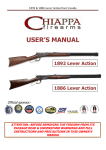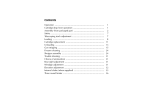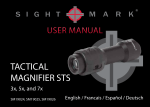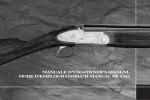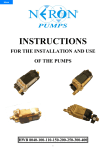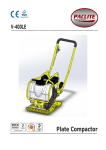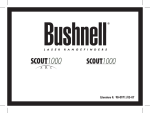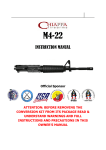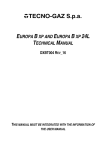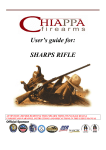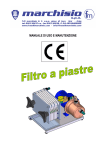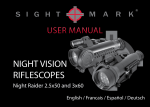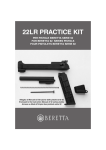Download Rottweil 580 User Manual
Transcript
MANUALE D’USO-OWNER’S MANUAL
MODE D’EMPLOI-HANDBUCH-MANUAL DE USO
Notes
Notes
2
THIS MANUAL IS EXTREMELY IMPORTANT.
The safety warnings and instructions in this booklet are very important. By understanding the dangers inherent in the
use of any firearm, and by taking the precautions described herein, you can use your shotgun in complete safety.
However, failure to heed any if the warnings may result in serious damage and injury or death to you or others as well
as severe damage to the firearm or other property.
Owner’s Manual - English
18
DANGEROUS WEAPONS
Shotguns are classified as “firearms” or "dangerous weapons" and are sold with the specific understanding
that the seller is in no way responsible for their illegal, improper or negligent handling or resale under local
laws and regulations.
The manufacturer shall not be responsible in any manner whatsoever for malfunction of the firearm, or for
physical injury or property damage, resulting in whole or in part from:
1. Criminal or negligent use of the shotgun
2. Improper or careless handling of the shotgun
3. Unauthorised modifications
4. Defective, improperly hand-loaded or reloaded ammunitions
5. Use of ammunitions not complying with CIP regulations or with similar standards issued by equivalent national bodies
6. Neglect
7. Other influences beyond the manufacturer's direct and immediate control.
This limitation applies regardless of whether liability is asserted on the basis of contract, negligence or strict
liability (including any failure to warn). Under no circumstance shall the Manufacturer be liable for incidental
or consequential damages, such as loss of use of property, commercial loss and loss of earnings or profits.
SAFETY WARNINGS – NOT JUST FOR BEGINNERS!
Regardless of your familiarity or experience with firearms, don't assume that you have no need to study this manual.
ALL GUNS ARE NOT ALIKE
Many makes and models of firearms may LOOK very similar. However, they differ widely in design and
operation, and in the location and function of various controls. Study this manual thoroughly. Learn all the
characteristics and operation of your particular firearm before attempting to handle it. Do not permit others to
handle it, unless they also have done so.You should have an instruction manual for every firearm you own. If
you do not, write the manufacturer and obtain one. Most manufacturers will gladly send you one free. If for
any reason a manual is not available, visit your library. Many books have been published which contain
detailed information on obsolete or discontinued firearms.
19
Owner’s Manual - English
The safe handling of firearms requires specialised training, discipline and caution. Firearms, by their own
nature and intended function, are deadly instruments. Accidental death or serious injury can result if they are
handled improperly or carelessly.
Firearms rarely cause accidents. Firearm accidents almost always are caused by a failure to obey the basic
rules of gun safety. Unfortunately, experienced shooters violate these rules as frequently as beginners. Thus,
the basic of safe firearms handling cannot be repeated too often. Read, re-read and memorise the basic
principles of firearms safety until they become second nature, habits that you do not forget.
If you have any question about your knowledge or ability to use this or any other firearm with complete
safety, you should seek supervised instructions. Personalised instruction is often available from gun dealers or
gun clubs. If none of these sources is accessible, write the National Firearm Association. THEY WILL ASSIST YOU.
A person with a gun in his possession has a full-time responsibility. HE MUST KNOW how to keep and use his/her
firearm safely and must always TAKE ALL THE PRECAUTIONS NECESSARY. He cannot guess, he cannot forget.
This responsibility is fully and exclusively his, it can not be passed off to someone else.
Remember: no gun can be made accident-proof. A gun is just a machine, with no judgement of its own; it
responds to your actions, whether wise or foolish. The only true effective safety device is the mind of a
cautious shooter who never forgets that a moment carelessness can produce permanent tragedy.
YOUR KNOWLEDGE CAN PREVENT INJURIES.
This shotgun was designed and is made to offer the maximum of safety when correctly used. However, as with
any other weapon, it is not foolproof and may become very dangerous if the following basic recommendations
are not RIGIDLY OBSERVED:
Owner’s Manual - English
20
READ CAREFULLY
1. Never, never point any gun, loaded or unloaded, at anything you do not intend to shoot.
2. Always treat every gun as if it were loaded.
3. Before using any gun, get instruction from a competent firearms instructor.
4. The safety is only a mechanical device, not a substitute for common sense.
5. Keep your fingers OFF the trigger until you are actually aiming at the target you intend to shoot.
6. Be certain the gun is unloaded before cleaning, changing chokes or storing.
7. Always empty the gun before entering a vehicle or an inhabited building
8. Never leave a loaded gun unattended.
9. Store guns and ammunitions separately, beyond the reach of children, in a locket container, cabinet, closet or room.
10. Never test the safety by pulling the trigger while the safety is on, unless you are absolutely sure the gun is
empty and you are pointing it away from everyone.
11. Be sure of your target before you shoot.
12. Do not mix guns and alcohol or drugs.
13. Never pull a gun towards you by the muzzle. Do not climb a tree or cross a fence with a loaded gun.
14. Load and unload your gun outdoors, with the muzzle pointed in a safe direction.
15. If your gun fails to fire when the trigger is pulled, keep it pointed at the target for at least 30 seconds.
Sometimes slow primer ignition will cause a "hang-fire" and the cartridge will go off after a short pause.
16. Never shoot at hard, flat surfaces or water. The slug or shot charge may ricochet.
17. When receiving a gun, always check to see that it is unloaded.
WARNING!
This shotguns was manufactured to perform properly with the original parts as designed. Your gun is a
complex tool, with many parts that must relate correctly to other parts. Putting a gun together wrong or with
modified parts can result in a damaged gun, danger and injury or death to you and others caused by
malfunction. Repair work should only be done by the manufacturer or a qualified gunsmith approved by the
manufacturer. Unauthorised repair will void your warranty.
21
Owner’s Manual - English
18. Never put your hands or any other part of your body over the muzzle of a gun, or allow it to point at any
other person. No harm should result if you obey this rule, even if an accidental discharge occurs.
19. Check ammunition to be sure it is the right caliber or gauge for your gun, and that it is not damaged or
malformed. Keep in mind that a 20 gauge shell will fall through the chamber of a 12 gauge gun and lodge in
the barrel. If a 12 gauge shell is then chambered and fired, the barrel may burst causing death or serious injury.
20. Always leave the safety on until you are ready to shoot.
21. Dry firing may damage your gun and is not recommended.
22. If there is any reason to suspect that something is obstructing the barrels, immediately unload the firearm
and look through both bores. It is not sufficient to merely look in the chambers.
23. Treat this gun as a precision instrument.
24. Old or reloaded ammunition may be dangerous. We recommend against using it.
25. Don't try to change your gun's trigger pull, because alteration of trigger pull usually affects sear
engagement and may cause accidental discharge. Altering your gun in any way may also void your warranty.
26. Before using “Steel-Shot” ammunition, check whether your gun is marked with the “French Lilly” symbol,
(see Picture.1), meaning that your gun was designed for this kind of ammunitions.
Write to us concerning any questions regarding items or circumstances which might relate to your safety
and the operation of our products.
PROTECT YOUR EYES AND EARS (See Picture 2)
Always wear adequate shooting glasses and ear plugs or ear protectors when you are shooting.
Always make certain that persons close to you are wearing similar protections. Unprotected eyes may be injured by powder gas, carbon residues, lubricants, metallic particles or similar debris which may emanate occasionally from any firearm in normal use. Moreover, without ear protection, repeated exposure to shooting noise
may lead to permanent hearing loss.
Owner’s Manual - English
22
AMMUNITION
1. Use only high quality, original, factory-manufactured shotgun shells, complying with CIP requirements or
other similar national standards. Do not use cartridges that are dirty, wet, corroded, malformed or damaged.
Do not oil cartridges or spray aerosol type lubricants, preservatives or cleaners directly onto cartridges or
where excess spray may flow into contact with cartridges.
Lubricants and other foreign materials on cartridges can cause potentially dangerous ammunition
malfunctions. Use only ammunitions of the gauge or caliber for which the firearm was chambered.
2. The use of reloaded, "remanufactured", hand-loaded or other non-standard ammunition voids all warranties.
Improperly loaded ammunition can be extremely dangerous and may cause severe damage to the firearm and
serious injury to the shooter or to others. Always use ammunition that complies with the industry performance standards established by CIP or other equivalent national bodies for other countries.
3. Firearms may be severely damaged and serious injury to the shooter or to others may result from any
condition causing excessive pressure inside the chamber or barrel during firing.
Excessive pressure can be caused by obstructions in the barrel, propellant powder overloads or by the use of
incorrect or defectively assembled cartridges.
In addition, the use of a dirty, corroded or damaged cartridge can lead to a burst cartridge case and consequent
damage to the firearm and personal injury from the sudden escape of high-pressure propellant gas from the
firearm's mechanism.
23
Owner’s Manual - English
4. If:
You have difficulty or feel unusual resistance in chambering a cartridge, or
A cartridge misfires or does not go off, or
The mechanism fails to extract a fired cartridge case, or
Unburned grains of propellant powder are discovered spilled in the mechanism, or
A shot sounds weak or abnormal, immediately stop shooting and check for possible obstructions in the
barrels. In such cases it is possible that a wad is lodged part way down the barrel. Firing a subsequent shot into
the obstructed barrel can wreck the firearm and cause serious injury to the shooter or to bystanders.
If there is any reason to suspect that something is obstructing the barrel (this can be anything – dirt, mud,
snow, sand, water, a wad etc.) immediately unload the firearm and look through both bores. It is not sufficient
to merely look in the chambers. An obstruction may be lodged some distance down the barrel, where it can not
easily be seen.
IF SOMETHING IS IN THE BORE, DO NOT ATTEMPT TO SHOOT IT OUT BY USING AN OTHER
CARTRIDGE OR BY BLOWING IT OUT WITH A BLANK OR A SHELL FROM WHICH THE SHOT HAS
BEEN REMOVED. SUCH TECHNIQUES CAN GENERATE EXCESSIVE PRESSURE, DAMAGE THE
FIREARM AND CAUSE SERIOUS PERSONAL INJURY.
Dirt corrosion or other foreign matter on a cartridge can impede complete chambering and may cause the
cartridge case to burst upon firing. The same is true of cartridges that are damaged or deformed.
Do not oil cartridges and be sure to wipe the chamber clean of any oil or preservative before commencing to
shoot. Oil interferes with the friction between cartridge case and the chamber wall that is necessary for safe
functioning and subjects the firearm to stress similar to that imposed by excessive pressure.
Use lubricants sparingly on the moving parts of your firearm. Avoid excessive spraying of any aerosol gun
care product, especially where it may get on ammunition. All lubricants and aerosol spray lubricants in
particular can penetrate cartridge primers and cause misfires. Some highly penetrative lubricants can also
migrate inside the shell cases and cause deterioration of the propellant powder: on firing, the powder may not
ignite. If only the primer ignites, there is the danger that the wad may become lodged in the barrel.
WARNING!
Discharging firearms in poorly ventilated areas, cleaning firearms or handling ammunitions may result in exposure to lead and other substances known to cause birth defects, reproductive harm and other serious physical
injury. Have adequate ventilation at all times. Wash hands thoroughly after exposure.
Owner’s Manual - English
24
HOW TO OPERATE THE SAFETY – WARNING!
Prior to firing, know and understand the operation of the safety by practising with the shotgun unloaded.
The safety is a rectangular sliding switch located on the tang of the action, directly behind the top lever of the
shotgun, which slides forward and backward. When the switch is at the rear end of its travel, the letter "S"
appears immediately in front of the switch (see Picture 3). This means that the shotgun will not fire when the
trigger is pulled. When the switch is in its forward-most position, the "S" is covered, which means the shotgun
is NOT ON SAFE and will fire when the trigger is pulled. (see Picture 4).
Warning
The safety switch on your shotgun, may not be automatic. In other words, it does not automatically go to the
SAFE position when the shotgun breech is opened and closed, but it must be manually moved to the SAFE
position. Never try to put the safety switch between the SAFE and FIRE positions. Unless the safety is positioned all the way forward or all the way to the rear, you can not be certain whether it is on SAFE or FIRE.
The safest way to carry this shotgun is WITH NO shells in the chamber. If you feel that you must carry the
shotgun with shells in the chambers, then the safety MUST BE ON SAFE ("S"). When you are ready to fire,
the safety can quickly be moved to the FIRE position. The only time when the safety should be placed in the
FIRE position is when you intend to shoot.
Warning
Never disassemble the safety mechanism. It has been correctly designed, fitted and tested. Any mechanical
device can fail, however, so never rely on the safety to justify careless handling or use. Never use a firearm if
the safety does not function properly.
25
Owner’s Manual - English
HOW TO LOAD YOUR SHOTGUN
Warning
Never attempt to load your gun with ammunition that does not meet the cartridge designation stamped on the
inside of the action (see Picture 5). This designation is only visible when the shotgun's action is open.
Warning
Before loading this shotgun, always check the bores to be sure they are free of grease, oil or any other
obstruction. Be sure the chambers are empty and the safety is on SAFE.
Before opening the action of the shotgun, make sure that the gun is pointed in a safe direction. With one hand,
move the top lever to the right as far as it will go (see Picture 6) (don't use excessive force, the lever should
move easily). With the other hand, pull down on the barrels until the action is fully open. Insert one or two
shells of the proper gauge into the chambers.
Keeping your fingers away from the trigger and out of the action, close the action by pulling up on the
barrels until it snaps shut. Do not use excessive force in closing the action, it should close easily and you should
hear an audible "click" as the action locks. When the action is closed and locked, the top lever will return to
its former position (Picture 7) pointing straight to the rear. If it does not do so, do not attempt to fire the gun,
as the action is not fully locked and damage to the gun and serious injury to you or others may result.
Closing the action automatically cocks the firing pins on both barrels. As soon as the action is loaded and
fully closed, the gun is cocked and ready to fire. Unless you intend to fire the gun as soon as it is loaded, the
safety switch should be kept in the SAFE position.
HOW TO FIRE
With the gun pointed at the target, move the safety to the FIRE position (all the way forward), aim, and pull
the trigger. The selected barrel will fire. To fire the second barrel, pull the trigger again. If you don't fire both
shells, be sure to put the safety on SAFE until you are ready to shoot again.
Owner’s Manual - English
26
FIRING SEQUENCE for guns equipped with SELECTIVE SINGLE TRIGGER
The safety switch on the tang of your shotgun has a dual function. In the center of the switch there is a button
that can be moved to the left and to the right. The position of this button determines which barrel will fire first
when the trigger is pulled. When the button is moved to the right (Picture 8) a single black dot is revealed,
which means that the bottom barrel has been selected to fire first. If the trigger is pulled again, the top barrel
will then fire. If the shooter wishes the top barrel to fire first, the button should be moved to the left, revealing
two black dots (see Picture 9).
EJECTORS (when provided)
Some shotguns are fitted with automatic ejectors (see Picture 10) that eject fired shells when the action is opened. The ejectors will not eject unfired shells. If two shells are loaded but only one has been fired, only the
fired shell will be ejected.
Warning
Take care not to point the rear of the action toward yourself or another person when opening the action.
The fired shells are rejected with enough force to cause possible eye injury.
HOW TO UNLOAD THE SHOTGUN
With the safety in SAFE position, and the shotgun pointed in a safe direction, open the action and manually
remove the unfired shells from the chambers. The ejectors will pull the shells from the chambers far enough
that you can reach them with your fingers.
Warning
Before placing the shotgun in a vehicle or returning it to storage, always unload it and visually inspect the
interior of the chambers to make sure that they are empty.
HOW TO CLEAN YOUR SHOTGUN
Warning
Before cleaning the gun, be certain that it is completely unloaded and the action is open.
Never attempt to clean a loaded firearm. Follow "How to Unload" instructions before cleaning.
Regular, proper cleaning of your shotgun will help to extend its useful life and assure proper functioning.
Cleaning is especially important if the gun gets wet or if foreign material gets into action or barrels.
To clean the chambers and bores, you will need a standard commercial shotgun cleaning rod, a bronze bore
bush of the proper diameter, a powder solvent and cleaning patches. Never use a steel bore brush as it may
damage the bore. It is usually wise to use a solvent that also removes the traces of plastic that are sometimes
27
Owner’s Manual - English
WHAT TO DO IF SHOTGUN FAILS TO FIRE
1. Misfires: if you squeeze the trigger and the cartridge does not fire, remain in the shooting position and count
to 30. Then move the safety switch to SAFE and open the action to remove the misfired cartridge from the
gun.
2. Underpowered shot: an underpowered cartridge is unusual if the ammunition is fresh, clean and factory loaded. However, if you hear an unusual sound or low report, you should stop immediately and proceed as follows:
As the wad and powder from the shell may still be in the barrel, you must unload the gun completely and
then look through both barrels from the action end (not from the muzzle) to see if there is any obstruction.
A wad can usually be removed with a cleaning rod. If not, it or any other stubborn obstruction should be
removed by an authorised gunsmith.
Owner’s Manual - English
28
left in the bores during the passage of wads.
First, run a patch saturated with solvent through the bores and let it stand for a few minutes. Then run the
bronze brush through the bores, followed by clean, dry patches. Use additional dry patches until they come out
clean. If necessary, repeat the entire procedure. Finally, run a patch through the bores that has been saturated
with light gun oil to protect them from rust.
Dry and clean the outer surfaces of the gun with a soft cloth, removing all moisture and fingerprints. You may
find an old toothbrush useful for cleaning hard-to-reach crevices. Finally, apply a light coat of gun oil to the
action and all external metal surfaces. Do not over-oil. Applying a small amount of light gun grease to the
action hinges and to the surfaces where the metal of the forearm and the action meet once or twice a year (more
often if the gun is heavily used) will help to make the gun open and close smoothly.
Occasionally rubbing in a light coat of line seed oil, will help to keep the wood of the stock in good
condition and preserve its beauty.
DISASSEMBLING INSTRUCTIONS
If you wish to disassemble the gun for transport or storage, proceed as follows:
1. Place the safety switch to SAFE
2. Make sure the shotgun is unloaded
3. In the center of the underside of the forearm stock, there is a release lever located in an oval depression in
the wood (Picture 11) or a release button positioned at the top end of the forearm (see Picture 12).
To remove the forearm, push the button or pull the release lever toward the rear of the gun while pulling the
front end of the forearm away from the barrels. Move the top lever to the right and open the action.
The barrels may then be lifted away from the action.
4. Reassemble in reverse order. It is not necessary to pull the release lever when re-installing the forearm. Place
the rear end of the forearm position, then push the forearm toward barrels. It should snap easily into place. Do
not use excessive force.
USE OF STEEL SHOTS
only for Steel-shot proofed guns, stamped with the French Lily symbol on the barrel (see Picture 1)
Warning
Steel shots are substantially harder than lead shots. They are enclosed in a plastic wad to help protect the
barrel from scoring by the hard steel shot. However, when the steel shot charge passes through the choke constriction in the barrel, the barrel or screw-in choke may be damaged if a tightly constricted choke is in place.
For that reason, we strongly recommend that a choke of no greater constriction than Modified (***) be used
when firing steel shots. Use of an Improved Modified (**) or Full (*) choke when firing steel shots will void
your warranty.
TECHNICHOKE® SYSTEM
The TECHNICHOKE® interchangeable choke system allows you to match the choke of your gun to expected
shooting conditions, or to quickly change the choke when you need to adapt the gun to different conditions at
the range or in the field.
29
Owner’s Manual - English
NOTE: Further assembly of your shotgun is not recommended and should be done only by an authorised gunsmith or by the Manufacturer.
During freezing conditions, oil may congeal and cause sluggish operation of your gun, therefore it is
recommended that only a very thin coat of light oil be used in these conditions.
Condensation droplets of water may form soon after a cold firearm is brought into a warm room. The gun may
also become wet during inclement weather. In these cases all moisture should be removed immediately to avoid
the formation of rust. Exterior metal finishing may be wiped down with a lightly oiled cloth.
For long term storage, lightly oil the bore, barrel and action with gun oil. Your firearm should be completely
unloaded and stored in a dry area. Never store your shotgun in a carrying case.
Shotguns 12-16-20-28 gauge come equipped with three or five different interchangeable screw-in or extended
chokes, depending on model. Each choke set also includes a choke wrench to facilitate switching of chokes.
We recommend that a thin coating of light gun grease be applied to the threads of chokes before they are
installed in the barrel.
Owner’s Manual - English
30
CHOKE SELECTION BY "TOUCH"
A unique notching system allows TECHNICHOKES® to be easily identified in minimal light conditions, as
shown in the following chart:
Number of slots on
choke tube
I
II
III
IIII
IIIII
No slots
Type of choking
Choke Designation
Type of choking
0
00
000
0000
Skeet
CL
Full
Improved Modified
Modified
Improved Cylinder
Skeet
Cylinder
1/1
3/4
1/2
1/4
Skeet
0/0
Warning
Always unload your shogun and open the action before changing chokes. NEVER fire your shotgun without a
choke installed as doing so may damage the threads and/or the barrels. Always make sure the choke is firmly
screwed into the barrel, but do not overtighten. Never use a choke that is bent or out-of round.
OVER-AND-UNDER SHOTGUNS
THREE BASIC RULES FOR A SHOTGUN OWNER
Most of firearm accidents are caused by the careless violation of one of the following basic rules:
1. Always keep the barrel pointed in a safe direction
2. Always treat every gun as if it were loaded
3. Always store your gun locked in a safe place when not in use.
31
Owner’s Manual - English
IMPORTANT: ALWAYS KEEP THIS MANUAL AND NEVER THROW IT OUT
Keep this manual together with your shotgun and in case of sale, deliver it to the new owner together with the gun.
Si certifica che questo fucile è stato sottoposto dal Banco Nazionale delle Armi da fuoco portatili di Gardone Val Trompia (Brescia
Italia) alla prova obbligatoria prevista dalla Normativa C.I.P. (Commission Internationale Permanente). Il fucile ha impresso sulla
bascula e la canna i prescritti marchi di prova, i dati del peso della canna, la lunghezza ed il diametro della camera di cartuccia ed il
diametro delle canne a 23 cm. dalla culatta.
Nous certifions que ce fusil a été soumis aux essais obligatoires prévus par les règlements de la C.I.P (Commission Internationale
Permanente). Ces essais ont été effectués par le Banc des Armes à feu portatives de Gardone Val Trompia (Brescia – Italie).
Les poinçons d'essai officiels sont gravés sur la bascule et sur le canon, avec les indications du poids du canon, de la longueur et du
diamètre de la chambre à cartouches et du diamètre des canons mesuré à 23 cm de la culasse.
Es wird bestätigt, dass das Gewehr vom Banco Nazionale delle Armi da fuoco portatili (vom Nationalen Amt für tragbare
Schusswaffen) in Gardone Val Trompia (Brescia – Italien) der von der Vorschrift des C.I.P. (Commission Internationale Permanente)
vorgesehenen Pflichtprüfung unterzogen wurde.
Auf dem Gewehr sind auf der Rast und dem Lauf die vorgeschriebenen Prüfmarken, die Daten über Gewicht, Länge und Weite der
Patronenkammer in einem Abstand von 23 cm vom Bodenstück eingeprägt
Se certifica que este fusil ha sido sometido a la prueba obligatoria prevista en la Norma C.I.P. (Commission Internationale
Permanente) por el Banco Nacional de Armas de fuego portátiles de Gardone Valtrompia (Brescia Italia).
El fusil lleva grabadas sobre la báscula y sobre el cañón las marcas de prueba prescritas, los datos del peso del cañón, el largo y el
diámetro de la recámara de cartuchos y el diámetro de los cañones a 23 cm. de la culata.
79
Certificato - Certificate - Certificat
We certify that this shotgun was proofed in compliance with C.I.P (Commission Internationale Permanente) regulations; such proofs
were performed by the National Proof House for Firearms in Gardone Val Trompia (Brescia – Italy).
Proof marks and barrel weight, length and diameter of cartridge chamber and barrel diameter at 23 cm from the breech are stamped
on the action and barrel.
Esploso - Exploded View - Dessin d’ensemble
80



















